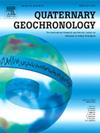An evaluation of two cryptotephra quantification methods applied on lacustrine sediments with distant Laacher See tephra fallout
IF 2.5
2区 地球科学
Q3 GEOGRAPHY, PHYSICAL
引用次数: 0
Abstract
Detailed quantification of volcanic glass is crucial for improving the resolution of paleoenvironmental reconstructions and facilitating more accurate comparisons between distant sedimentary cryptotephra records. Here we present and evaluate two methods for the quantification of cryptotephra, shown on lake sediments from a site with distant Laacher See tephra fallout. Our methods initiate with delineating the extent and distribution of the cryptotephra layer within the sediments, accomplished through the integration of X-ray fluorescence (XRF) and computed tomography (medical- and μ-CT). The first quantification method involves the well-established process of shard extraction through stepwise density separation, followed by improved and statistically evaluated quantification introducing a new standardized marker. While the method itself is used widely for many years among cryptotephra researchers, we demonstrate how the new marker improves its precision for cryptotephra quantification, providing a robust, straightforward laboratory-based technique. Additionally, we introduce an innovative, software-based method that combines an SEM-based automated mineralogy analysis on thin sections with customized image analysis, which allows to study the area fraction of the glass phase, its depth-dependent variation, particle concentration with a focus on clustering behavior, depth-dependent particle count, total particle count, and particle size distribution within the glass phase. The significance of both methods lies in the efficiency and precision of cryptotephra quantification, enabling a deeper understanding of shard concentration and distribution. This study emphasizes the methodological innovations, offering improved tools for cryptotephra quantification, without focusing on detailed application-based analyses.

两种隐绦虫定量方法在湖泊沉积物中应用的评价
火山玻璃的详细量化对于提高古环境重建的分辨率和促进遥远沉积隐层记录之间更准确的比较至关重要。在这里,我们提出并评估了两种量化隐绦虫的方法,这些隐绦虫显示在遥远的Laacher地区的湖泊沉积物上。我们的方法首先通过x射线荧光(XRF)和计算机断层扫描(医学和μ ct)的整合来描绘沉积物中隐球菌层的范围和分布。第一种定量方法包括通过逐步密度分离的碎片提取过程,然后是引入新的标准化标记物的改进和统计评估定量。虽然该方法本身在隐隐体研究人员中广泛使用了多年,但我们展示了新的标记物如何提高其对隐隐体定量的精度,提供了一种强大的,直接的基于实验室的技术。此外,我们还引入了一种创新的基于软件的方法,该方法将基于sem的薄片自动矿物学分析与定制图像分析相结合,可以研究玻璃相的面积分数,其深度相关的变化,专注于聚类行为的颗粒浓度,深度相关的颗粒计数,总颗粒计数和玻璃相内的粒度分布。两种方法的意义在于隐隐phra量化的效率和精度,可以更深入地了解碎片的浓度和分布。本研究强调方法上的创新,为隐球菌量化提供改进的工具,而不是专注于基于应用的详细分析。
本文章由计算机程序翻译,如有差异,请以英文原文为准。
求助全文
约1分钟内获得全文
求助全文
来源期刊

Quaternary Geochronology
地学-地球化学与地球物理
CiteScore
4.40
自引率
22.20%
发文量
130
审稿时长
20 weeks
期刊介绍:
Quaternary Geochronology is an international journal devoted to the publication of the highest-quality, peer-reviewed articles on all aspects of dating methods applicable to the Quaternary Period - the last 2.6 million years of Earth history. Reliable ages are fundamental to place changes in climates, landscapes, flora and fauna - including the evolution and ecological impact of humans - in their correct temporal sequence, and to understand the tempo and mode of geological and biological processes.
 求助内容:
求助内容: 应助结果提醒方式:
应助结果提醒方式:


